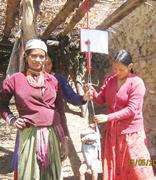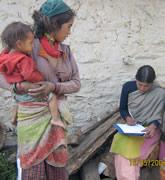|
Humla villages, lie between 2400 m and 4000 m altitude, in a rough climate in the middle of the Himalayas. Humla is known as a constant food shortage area. In a good year the fields yield crops which provide the local people 4 to 5 months per year with just enough food, to survive. The staple food in Humla is "roti" (unleavened flat bread) with vegetables or chili. "Rotis" are made out of barley, corn or millet flower. In the upper Humla region where RIDS-Nepal is working, no rice is growing due to the harsh climate. Thus rice is eaten only at rare and special occasions as it has to be either purchased at high price or carried in from Tibet in China. Thus one is not surprised to find that about 65% of the children under 5 years of age are malnourished as according to the UN's (United Nation) children's growth table. The RIDS-Nepal Nutrition Department tries to find ways to address this urgent and dire conditions through a long-term, intensive and very practical nutrition program.
It is not only heart breaking to see how innocent children suffer and die due to malnutrition, but it is also unjust and against the order of creation. How desperate people are in Humla we experience first hand in the villages and through the high death rates of children. Not seldom we meet women who have given birth to 8 and more children, but have only 3 or 4 with them . . . Many died of malnutrition.
RIDS-Nepal Nutrition Programme
  RIDS-Nepal's Nutrition programme works with the most malnourished children under 5 years of age and their mothers in those villages where previous "Family of 4" projects have been implemented and then the local people have requested a nutrition programme to start. Up to 15 families per village with a malnourished child are included in the programme. Each child is enrolled in a special developed food program, which RIDS-Nepal has developed together with local available food ingredients. The mothers are trained how to prepare the food and how to feed their child. Each child is monitored and checked, with data measurement and recording, on a monthly basis, while the mothers are visited once a week for instructions and counseling. One of the tests involves weighing the child for its growth. These data are plotted on the child's growth chart, so that its development can be tracked and if necessary immediate actions can be taken accordingly. The data is also recorded digitally and graphically presented which helps to keep a clear track of each child's status and growth pattern over time. That allows as well to conduct further studies and analysis of the effectiveness of the program and appropriate changes and adjustments to improve the nutrition programme can take place in time. RIDS-Nepal's Nutrition programme works with the most malnourished children under 5 years of age and their mothers in those villages where previous "Family of 4" projects have been implemented and then the local people have requested a nutrition programme to start. Up to 15 families per village with a malnourished child are included in the programme. Each child is enrolled in a special developed food program, which RIDS-Nepal has developed together with local available food ingredients. The mothers are trained how to prepare the food and how to feed their child. Each child is monitored and checked, with data measurement and recording, on a monthly basis, while the mothers are visited once a week for instructions and counseling. One of the tests involves weighing the child for its growth. These data are plotted on the child's growth chart, so that its development can be tracked and if necessary immediate actions can be taken accordingly. The data is also recorded digitally and graphically presented which helps to keep a clear track of each child's status and growth pattern over time. That allows as well to conduct further studies and analysis of the effectiveness of the program and appropriate changes and adjustments to improve the nutrition programme can take place in time.
|
A digital plot of the child's growth curve over time
for a child based on the monthly measured
and recorded data during checkup
|
A child growth chart over time for a child from
Chauganphaya village showing the Actual Weight of
the child (blue line) against theRecommended Weight
(pink line ) and Malnutrition Threshold (yellow line)
|
Special "Mother's Groups" have been formed, where they can share they can receive counselling from RIDS-Nepal's trained staff as well as where they can share their experiences. They are also taught how to prepare more nutritious meals with what they have available. The mothers are taught how to make "sarbotam pito" (super porridge), a mixture of roasted soya beans, corn and wheat. But nothing is better than "mama's milk", thus strong emphasis is given to breast feeding. But "sarbotam pito" is nutritious, easy to make, because it's made out of people's staple food, and the weighing scale "happily" shows the result. Mama is pleased ... but best of all, children love to eat it.
Key of Love
Take the following text for the 5th paragraph:But it is the "Key of Love" which helps a child to cope and go through such an unfair and harsh life experience in its young age. And who's love is that....all family members' love though mostly mama's love. In all its endeavor to promote and teach mothers how to prepare better and more nutritious food RIDS-Nepal foremost teaches the mothers to love their little ones, and to "fight" for their life, rather than to wait for the next child to be born, ......and with most likely the same fate....
|





